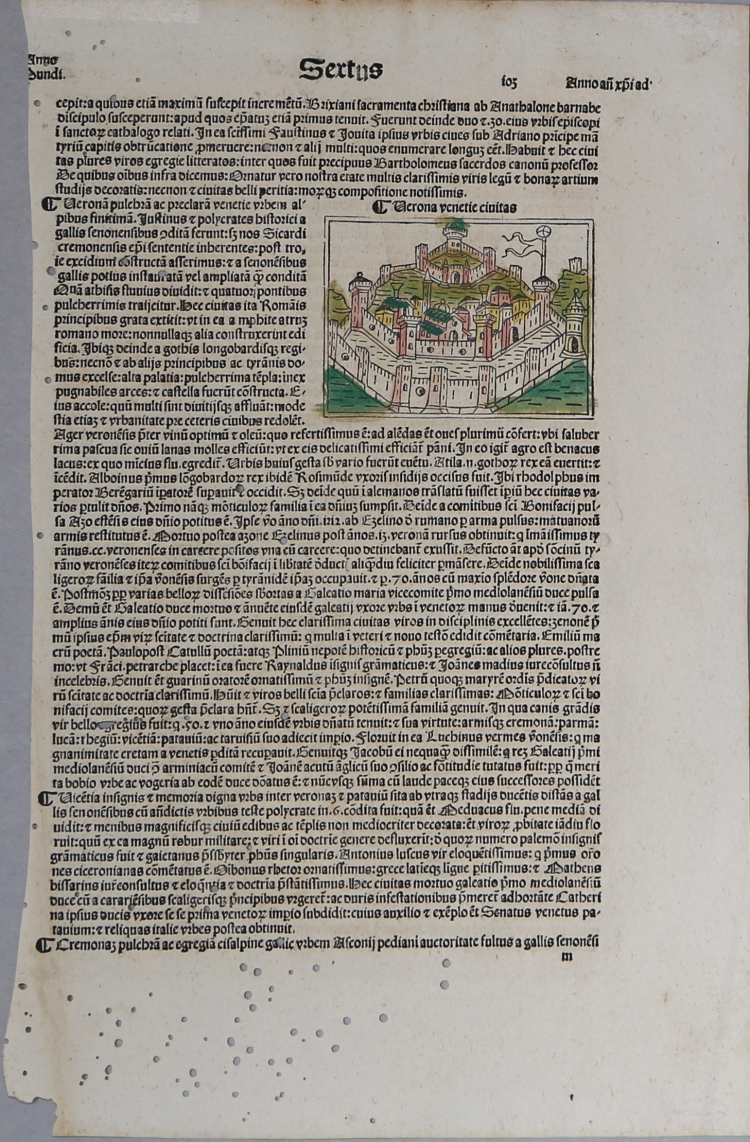



| Reference: | S22238 |
| Author | Werner Rolevinck |
| Year: | 1474 ca. |
| Zone: | Verona |
| Printed: | Cologne |
| Measures: | 75 x 60 mm |


| Reference: | S22238 |
| Author | Werner Rolevinck |
| Year: | 1474 ca. |
| Zone: | Verona |
| Printed: | Cologne |
| Measures: | 75 x 60 mm |
An imaginary view taken from Werner Rolevinck's Fasciculus Temporum - the first history of the world ever created. Woodcut, set in a text page, contemporary colour, many worm holes but generally in good conditions.
The Westphalian Werner Rolewinck (1425-1502) was a Carthusian monk in the Charterhouse of Cologne or Utrecht; little else is known. ‘Fasciculus temporum’ was his masterpiece, with dozens of editions appearing in Latin, French, Dutch and German solely in his lifetime. Based on major Christian historiographic sources like Orosius and Eusebius, ‘Fasciculus’ presents a history of the world in the form of a genealogy—a traditional historiographic structure dating back to late antiquity—leading the reader from the Creation to the pontificate of Sixtus IV.
In 1474 printer Arnold Ther Hoernen of Cologne, issued the first dated printed edition of the Fasciculus temporum.
Another undated edition of Rolewinck's book was published by Nicholaus Götz, probably in Cologne and not before 1474.
Rolevinck's work also contains some of the earliest evidence of collaboration between an author and his printer in the design of printed books. A few contemporary manuscripts that have survived, such as those for the Nuremberg Chronicle, are similar to the complex typography and woodcuts of the printed edition, but none have been demonstrated to be the author's exemplar for the printer. (cfr. Wilson, The Making of the Nuremberg Chronicle [1976] pp. 38-41).
"The Fasciculus temporum, a fifty-age linear chart that moved from the Creation to the present, set out to give readers an overview of world history: a readable visual presentation that they could treat as both a memory system and as the spark for religious meditation. Rolevinck used a system of coordinated circles to locate biblical, classical and modern rulers and writers in the flow of historical time—a system so complicated that the first printer who grappled with it botched the job, producing an unintelligible text; later printers reasurred readers that they had followed the author's manuscript. And the results were most impressive: a neatly designed, powerfully horizontal line of time plunging forward from the Creation to the present. Around it nearly arranged and coordinated name bubbles and extracts from historical texts put meat on the book's numerical bones" (Rosenberg & Grafton, Cartographies of Time [2010] 28-30, with illustrations).
Werner Rolevinck (1425 - 1502)
|
Werner Rolevinck was a Carthusian monk and historian who wrote about 50 titles. He was born near Laer, Westphalia, the son of a wealthy farmer. In 1447 he entered the Carthusian Monastery of Santa Barbara in Cologne where he died. His most famous work was his history of the world from Creation to Pope Sixtus IV, Fasciculus temporum, which was published in many editions between 1474 and 1726, including almost 40 editions during his lifetime. His only other well-known work was a description of the manners and customs of his native land entitled De laude veteris Saxsoniæ nunc Westphaliæ dictæ
|
Werner Rolevinck (1425 - 1502)
|
Werner Rolevinck was a Carthusian monk and historian who wrote about 50 titles. He was born near Laer, Westphalia, the son of a wealthy farmer. In 1447 he entered the Carthusian Monastery of Santa Barbara in Cologne where he died. His most famous work was his history of the world from Creation to Pope Sixtus IV, Fasciculus temporum, which was published in many editions between 1474 and 1726, including almost 40 editions during his lifetime. His only other well-known work was a description of the manners and customs of his native land entitled De laude veteris Saxsoniæ nunc Westphaliæ dictæ
|